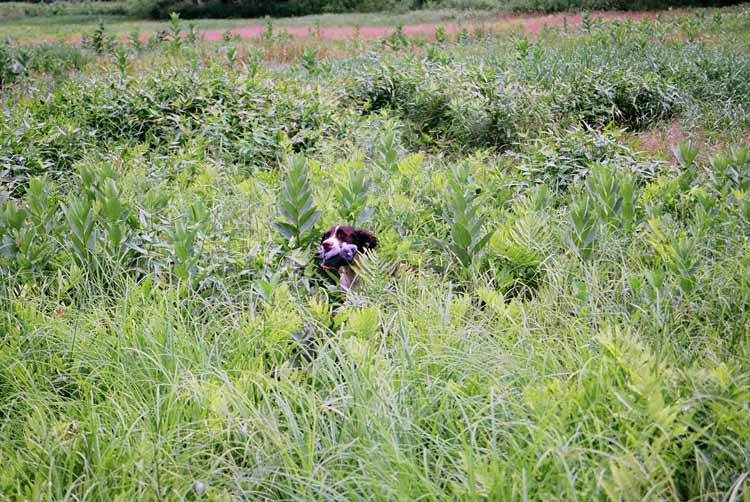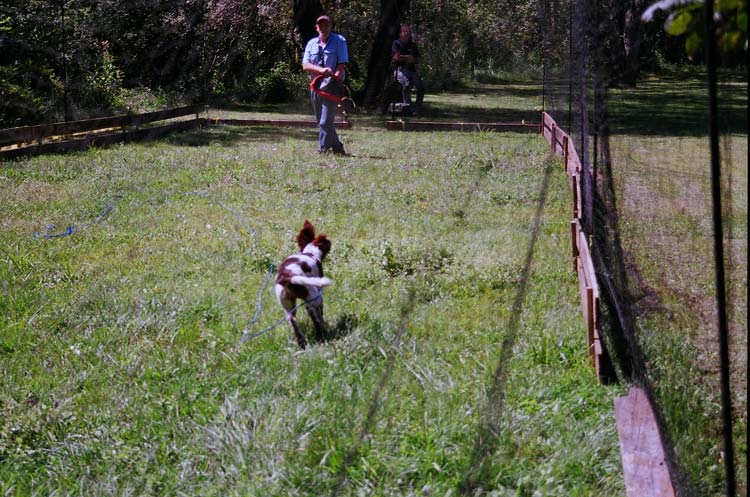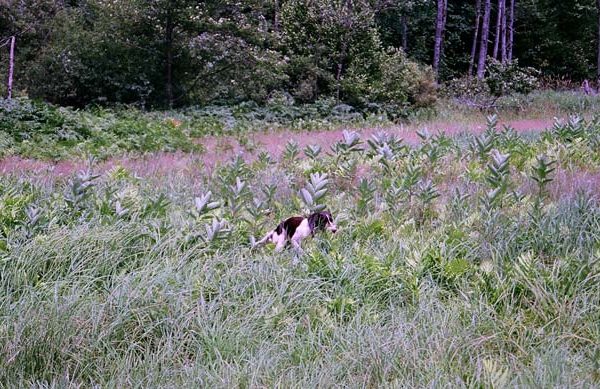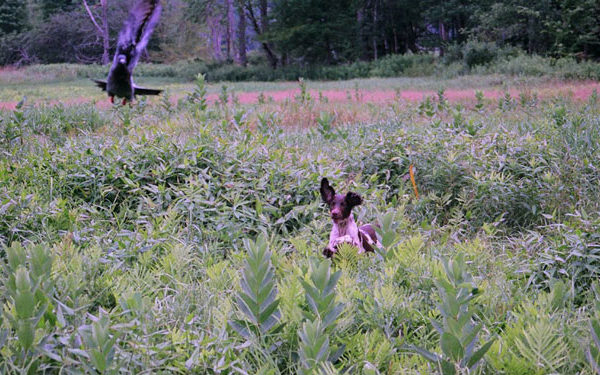
The Spaniel hunting test game has entered its fifteenth year. Boy it sure does seem like only yesterday that this sport was introduced. Through the years we have witnessed many changes as this game has gained in popularity. We are now starting to see more consistencies in the set up and qualifying on the various levels of AKC Hunting tests for Spaniels.
Many of the new challenging concepts and environmental hazards that we are experiencing at the Master level for blind retrieves both on land and water, has made many realize the all to important fact. To qualify at this level we must have a spaniel that is trained to stop and handle during a blind retrieve scenario.
The blind retrieve occurs when a bird has fallen into an area that the spaniel has not seen the bird go down. The handler must direct his spaniel to the fallen game by use of whistle and hand direction. The spaniel is going because he has the confidence in his handler. Knowing “there is a bird out there” trustingly following the handlers cast to the proper direction of the fallen game. The handler must communicate a balanced attitude of confidence to the dog. Communicating the attitude “I will get your nose down wind and you can do the, trust me”.
There are many cases while we are hunting that a blind retrieve properly schooled will make the difference between dinner on the table or feeding the local predators through the winter. With today’s modern society many of the avid small game hunters are requiring a gun dog that is capable of wearing many different hats. Not only must the spaniel be a good family companion. They also must contend to an all-around gun dog as well. Today’s small game hunter requires one dog that can do it all. Thus water fowling is becoming more and more of a demand on the spaniel today. In the duck business the blind retrieve is used more often than in upland game hunting. Mainly due to the type of cover that surrounds those hot spots that hold the ducks. Naturally marking is a difficult issue to say the least! Many times the scenario is that the spaniel has not seen the location of a fallen duck and they must take a line for a blind retrieve.
The upland hunter can additionally require a blind retrieve as well. Issues such as sending your spaniel to the opposite side of a river bank, or pond to retrieve a crippled bird that has gone down out of reach. This forum we will teach the blind retrieve in many separate pieces like a puzzle, each component schooled separately. Then finally all pieces will be constructed together to do a true blind retrieve.
We must develop good attitude and a strong desire on blinds. When we send our spaniel to search for a blind bird. They should leave our side in the same fashion as they would if we were sending them for a marked retrieve. This will be the most difficult thing to maintain throughout the stages of training. Once we have developed proper attitude and desire. The spaniel will work very hard to “please” and take their cast with enthusiasm and intent.
Lining will be taught to get the spaniel to take a good initial line in the direction of the blind bird. Stopping is incorporated to stop the spaniel once they have drifted off the initial line. Finally casting will be taught to get the spaniel back onto his proper line and finally downwind of the blind bird.
Teaching blinds for the spaniel will naturally differ from the way that retrievers are taught. Our goal is to assist by handling the spaniel into the fall area downwind of the bird. Once there, the spaniel shall quest for the fallen bird by showing noise to locate the game and finally returning with the retrieve.
The training equipment that will be needed are one dozen white, one dozen orange and one dozen black retrieving dummies, 30 foot check cord, a retriever style whistle, one dozen or so small surveyors flags and naturally birds. Locate a spot in your area where you can set up training concepts and leave the area set up to return to daily while schooling. You will need an area that has relatively no cover to start. Eventually you will like to find additional areas that will offer many different cover changes for the final polish.
Before we get started your spaniel must have several basic things well-schooled in advance to starting this form of training! They must not have any retrieving issues what so ever. They should find, pick up and deliver all retrieving tools used whether it is dummies or birds. Basic obedience must be completely ingrained hup, here, heel and no must be obeyed at all times. The spaniel also must be steadied to dummies and birds being thrown and only retrieve when sent. Also they should stop reliably on the whistle at any distance from the handler.
We’ll start to teach beginning stages of three handed casting. The lining drills can be done at the same time if you wish. However you will need two separate areas to do these drills. This column will cover basic three- hand casting. Next column I will review the lining concepts. As I mentioned above find yourself a field that has little to no cover. The field should be a minimum of one hundred + yards long and at least 60 yards wide.
OK first before we start with the dog- training let us first start with you the teacher! Stand in front of a mirror and practice your hand signals. We must make sure that you are sending the proper hand signal to the spaniel and not confusing them! Remember the final stages of schooling your dog can be as far as one hundred + yards away. You must give clear solid hand signals to get the proper cast out of your dogs. Additional always start and finish with your hands in the “prayer” position. This consists of having both your hands held together in the center of your chest. When you execute a cast keep the other hand stationary on your chest. Movement of the hand that is not giving the cast can cause the dog to become confused! Once you have executed the cast return to the prayer position. Making ready in-case you should need to stop the spaniel for an additional cast.
The first command is “BACK” step forward one step and throw your hand straight up over your head. As if you were reaching for a baseball that was hit right over the top of your head. Facing the open flat palm of your hand to the dog.
The next command is the “OVER” let do the left hand first. Take a step to your left and throw your left arm straight out to the side, pointing to the left. This is the over command. Remember that when you give an over cast face your thumb down towards the ground so the dog will see the backside of your hand. This will keep your arm at a ninety degree angle to your body. Thus preventing you from making a casting mistake and throwing an angle back that will confuse your dog. Now for the right hand cast repeat the procedure only to the right side. Does your hand casting look clear and clean to you in the mirror along with your body language? It should and if it does I am sure that it will look as good to your spaniel out in the field.
Now it’s time to start teaching your spaniel. Take a couple of white dummies, a flat collar and a check cord to the field. It is advisable to keep your dog on a check cord at this point. Remember we are going to keep this training short and in the form of a game at first. We want to develop good attitude and desire while teaching the introduction to casting. Let’s keep it simple so there will be no need for correction in the beginning.
Picture in your mind a baseball diamond. The spaniel will be on the picture mound and will throw the dummies and cast to first, second and third base. Set your spaniel at a remote HUP on the picture mound with them only five yards in front of you. Give a reminder to HUP and toss a dummy straight over the top of their head landing only seven or so yards away to second base where they can see it. Only hesitate a second or so and execute the back command. They may be reluctant to go at first but continue to give the command and coax them in a lavishing voice until they make the retrieve. Delivery of the dummy should be in the remote position facing you. Too much movement on side delivery can confuse the dog. We will only teach the back command first. Once the back command is well learned. You now can start to teach the left and right hand overs by using the same technique. The spaniel should be taking all three casts consistently when the retrieving dummies are thrown to all three bases.
Next with four dummies in hand and your spaniel on the picture mound. Throw a dummy to each base first, second and third. Keeping the last dummy for you in your hand. Take the check cord in your hand and choose which dummy you would like them to retrieve first. Should they choose the wrong one, give a normal tone “NO” tug on the check cord stopping them from retrieving the wrong dummy. Place them back on the picture mound and throw the extra dummy that you have to the proper base and send the dog. Continue to drill this until you can get the dog to pick up all the dummies around the bases at random selection.
Now can set out three distinct piles of dummies. A minimum of three different colored dummies per pile. Teach your spaniel to take random cast to your desired pile until all the dummies have been picked up. Some spaniels will get confused as to which dummy in the pile to pick up! We can help them with this by separating the dummies two feet away from each other. Let’s not make a big deal out of things if they do some switching at the dummy pile just encourage them to pick up and retrieve one. We want them to stay focused proper hand casting and not worried as to which dummy in the pile to pick up first! They will become quicker on their pickups at the dummy pile as they gain in confidence.
Help them when they get confused by again stopping them and throwing a dummy to the proper pile and send them for the retrieve. Now you will find that some spaniels will have a problem say with a left hand over or maybe a BACK command. Simply do a few extra drills of the weak cast until it become proficient. Now you can start to extend your casts by moving your piles further away from the pitcher’s mound. You now are well on your way to your dog taking a cast during the blind retrieve. However don’t attempt to handle your spaniel on anything other than the above yard work, this is only one small piece to the puzzle. Next month I will address lining drills. Enjoy your spaniel they are a wonderful gift!





